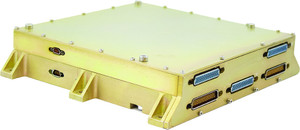
CDH-1
CAVU Aerospace UK Ltd
The CAVU CDH-FS is a state-of-the-art, fully redundant FPGA-based satellite onboard computer system. It’s designed with a backup processor board that seamlessly takes over in case of a primary processor failure, ensuring uninterrupted operation. This redundancy significantly enhances the system’s reliability and safety, a critical feature for space missions.
The onboard computer (OBC) is engineered to withstand various space hazards, including radiation, cosmic rays, and solar flares.
It utilizes a Microchip/Microsemi SmartFusion2 and ProASIC3 Flash Based FPGAs, which are not only SEU immune but also more power-efficient than conventional SRAM-based FPGA architectures.
| Parameter | Value |
|---|---|
| Dimensions | 205x203x87 mm |
| Mass | 4,250 g |
| Power Supply | 5V +/- 5% |
| Power Consumption | 3W ~ 5W |
| Processor | ARM Cortex-M3 on FPGA |
| FPGA 1 | Microchip/Microsemi SmartFuion2 Flash Based FPGA |
| FPGA 2 | Microsemi ProASIC3 Flash Based FPGA for Interaface |
| Processor Performance | 150 DMIPS @ 128MHz |
| Programming and Debug | SoftConsole/Keil via JTAG |
| RAM | 160Mbits MRAM 40 bits width (128Mbits+32Mbits ECC) |
| ROM | 96Mbits MRAM (Con figurable as Triple 32Mbits) |
| Nonvolatile Flash Memory | Total 24Gbit SLC NAND Flash (Triple 8G) |
| Serial FRAM | 256 Kbit |
| Serial NOR | 256 Mbit |
| Radiation Hardness | Total Ionizing Dose: 30Krad (Si)/yr |
| Latchup | SEE @ 60MeV |
| Operating Temperature Range | -40C to 85˚C @10^-8 torr |
| Shock | 2000g, 2000-10000Hz |
| Random Vibrations | 14g(RMS) 3-Axis , 20~2000Hz |
| DIGITAL/ANALOG Interface | Digital Outputs (5V/3.3V) : 100x |
| DIGITAL/ANALOG Interface | Digital Inputs (5V/3.3V) : 90x |
| DIGITAL/ANALOG Interface | PWM/Pulse Outputs (5V/3.3V) : 10x |
| DIGITAL/ANALOG Interface | 16bits Analog To Digital Converter (-10V~+10V) : 128x |
| DIGITAL/ANALOG Interface | Digital To Analog Converter (0V~5V) : 2x |
| Serial Interface | CAN2.0 Up to 1Mbps : 5x |
| Serial Interface | Full-Duplex RS422 : 8x |
| Serial Interface | Half-Duplex RS485 : 8x |
| Serial Interface | RS232 :1x |
| Serial Interface | I2C : 1x |
| Serial Interface | SPI : 1x |